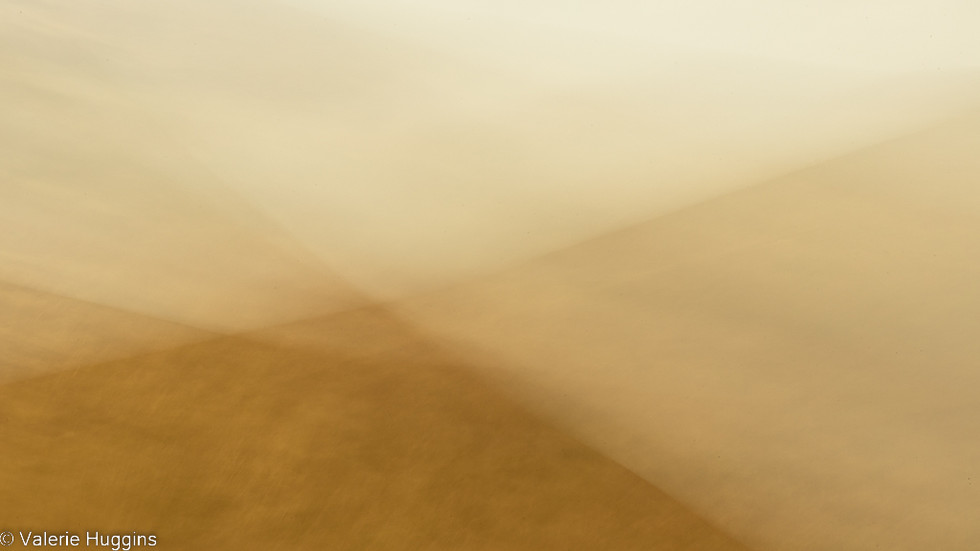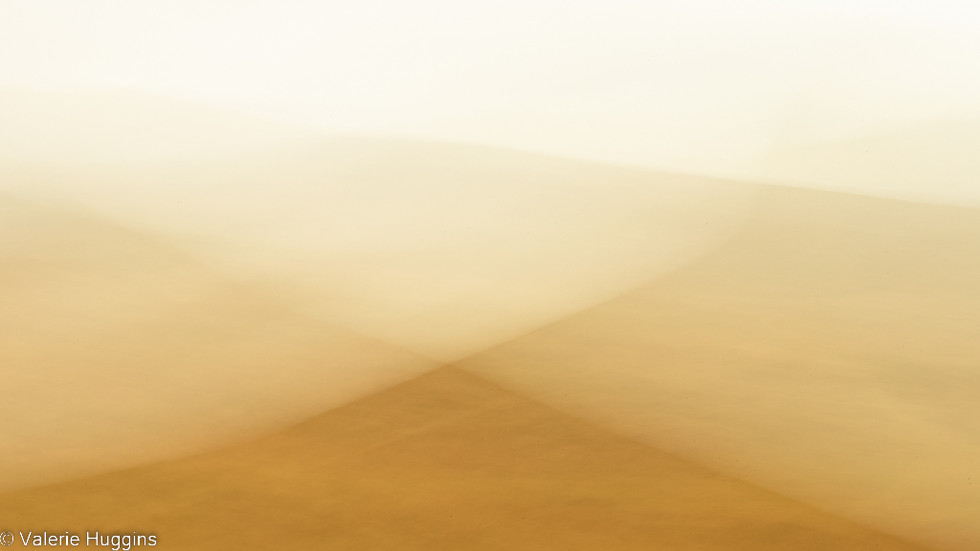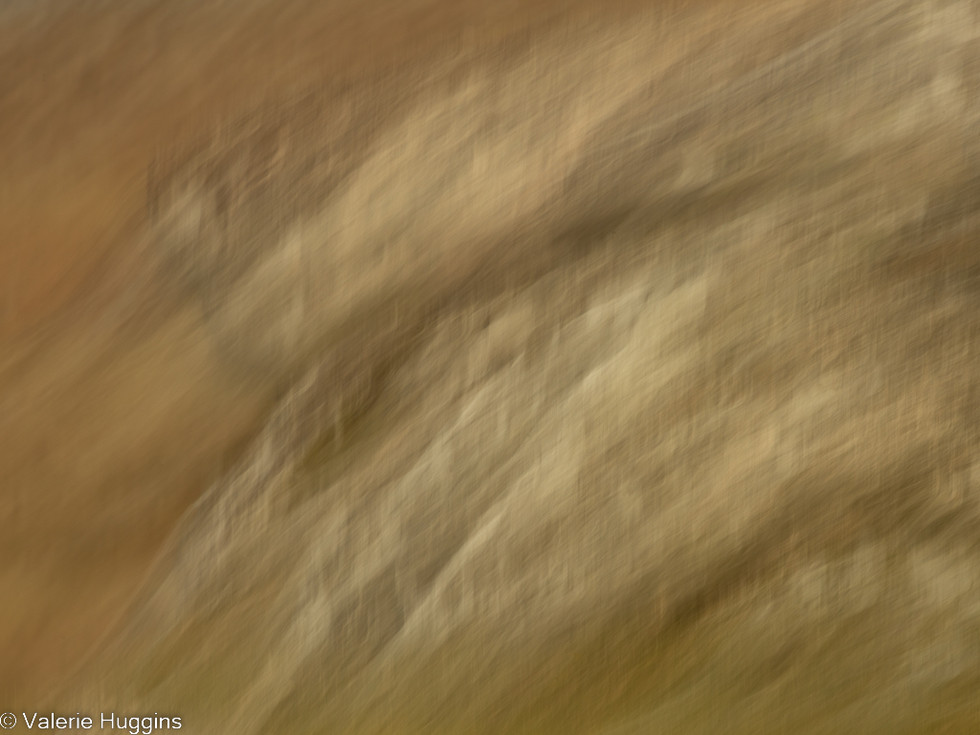Taking risks: seeking 'bleak' and 'wild'
- valeriehuggins0
- Feb 13, 2023
- 4 min read

The latest ICM (#intentionalcameramovement) challenge from #Charlotte Bellamy is to capture 'Bleak or Wild'. My thoughts immediately turned to nearby #Dartmoor, with its sweeping landscapes of moorland. I often go to different parts of the moor for photography, but I have not had much success previously in capturing the barrenness of the moor with ICM. The light has often proved tricky and the resulting images have lacked impact. But I now have more experience with using filters and it seemed the obvious place to go for 'bleak or wild'.
Although it was a dull day, there was still a lot of colour and I started with a 'typical Dartmoor landscape shot, similar to many that I have taken over the years.

Wrapped up against the chill February wind with my back against the cold granite of the tor, I sat and doodled 'bleak' words: empty, bare, desolate, cold, grim, dreary, deserted. And I looked across the landscape that stretched for miles. And yes, in many ways, it was bleak. Devon-born, these moors are part of my cultural heritage, one of my 'escape' places, and I have enjoyed the freedom to wander there since childhood. This is how I envisage the moorland: open, bare, desolate.
But this typical scene within the Dartmoor National Park is now at the heart of the contentious Rewilding debate. Campaigners such as George Monbiot argue that this moorland wants to be a temperate forest, but the tree seedlings are grazed out by the sheep, leaving behind 'sheepwrecked' 'ecological disaster zones'. In a powerful talk in 2015, George set out the arguments, calling out the National Park Authorities' failures in their care of the land and demanding changes.
Organisations such as Moor Trees are responding to these demands, pushing to rewild Dartmoor by planting woodlands to counteract the current biodiversity loss and to try and alleviate the impacts of climate change. I welcome these initiatives. There is considerable resistance though, with many people wanting to retain the current 'bleak' moorland, to 'conserve' the status quo, and many farmers concerned about their livelihoods. But sheep farming is no longer economically viable and other traditional industries are no longer able to sustain thriving local communities within our National Parks. Arguably, the future lies in rewilding, allowing the temperate forests to re-establish, along with the wildlife. Keystone species such as beavers, boar, lynx, maybe even wolves, would be reintroduced. The moor could go from 'bleak' to 'wild'.
So, this current photography challenge has thrown up considerable angst for me in how to represent it. Like bleak, 'wild' also could mean deserted, without humans, uncultivated, a wilderness, but is this not more positive? If this landscape that I was overlooking was truly 'wild', untamed, there would be no sheep grazing. Moor Trees state that at the end of the last Ice Age:
Britain’s climate became much milder and trees were able to repopulate our countryside. Dartmoor became a landscape of oak, birch, willow, rowan, hazel, and other native trees, with just a scattering of open areas on the highest and wettest ground. This expanse of woodland gave rise to an abundance of plant and animal life, including mammals like elk, aurochs, wolves, bears and beavers. In a word, the landscape and its inhabitants were barely recognisable from what we see across Dartmoor today.
With these thoughts tumbling and crashing in my mind, it was hard to get into a mindful flow, but that is part of the creative process too. Taking photos can a a risky occupation. There are so many decisions to make as a photographer and then once you add in serendipity, the outcomes are infinite. In his latest blog, Want Different Results, Try Different Things, #DavidDuChemin writes about risk-taking as a photographer, whether that involves physical, psychological or creative risk:
"The risk is that taking the time trying a new approach means you’ll be missing the chance to do the stuff that does work. The tried and true. Sure, you’ll be repeating yourself, but better to go home with some version of what you’ve done before than nothing at all, right?"
And I already know that I can take conventional images of Dartmoor. So I started by experimenting with ICM images of the view before me. I was aiming for a distillation of the elements and colours, but also some representation of the bareness, the desolate emptiness:
I then turned my attention to the rocks of the tor that were sheltering me:

There was an abundance of life flourishing there, clinging on against the odds. The textures, the colours and the patterns appealed, and I wallowed in playing with different effects to try and represent 'wild':
Recently I have started to experiment with in-camera multiple exposures - a new risk creatively. Ignoring the increasing chill in my fingers, and the mist rolling in, I tried out a few. I regretted not bringing the notes I had made on the talks given by Valda Bailey and Doug Chinnery as I struggled to remember their advice about which blend modes to use and so on. I set my Canon R to 3 exposures, bright mode, and moved the camera in-between each shot. I then tried dark mode too. A lot of 'near misses' (rather than say failures!) but there were a few that were interesting, producing abstract images that had retained sufficient elements to be recognisable as a Dartmoor landscape with its granite tors.


I then remembered Valda suggesting experimenting with the AWB, so I tried this out. This image really sings to me, a joy that emerged from that chilly day:

Suddenly here was an image that reflected my journey that day. The shift in the colour palette by changing the AWB is striking. This image has the solidity of the tors, the texture and colours of the landscape, along with a warmth that conveys my hopes for the rewilding of the Moors. It is close to the photographic expressionism that Doug Chinnery discusses in his fascinating blog. Am I now 'mentally emancipated from the need for slavish reproduction'? As David DuChemin reminds us 'The magic is outside the comfort zone. Sometimes we’re forced there, but most often, we need to choose it.' And that applies to us as photographers as well as to the stewards of our wild places.



















I so agree about rewinding Scotland and Cumbria would be richer the beaver could help with flooding , there are lots we could do and yes removing grazing in certain areas would be long term beneficial